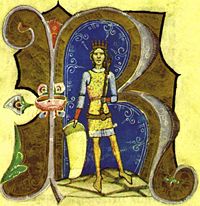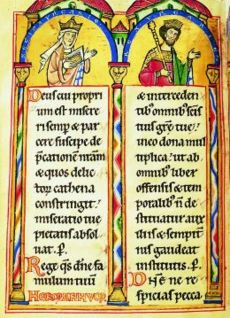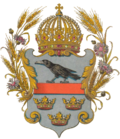Galicia-Volhynia
 From Nwe
From Nwe 
The Kingdom of Galicia-Volhynia or Galicia-Vladimir, was a principality in post-Kievan Rus' in the late twelfth century and existed until the middle of the fourteenth century. It is also called Galicia-Volynia, Halych-Volhynia, Galicia-Volyn, and Galich-Volyn. It extended between the rivers San and Wieprz in what is now south-eastern Poland in the west, and the Pripet Marshes (now in Belarus) and upper Southern Bug in modern-day Ukraine in the east. During its time, the kingdom was bordered by Black Ruthenia, the Grand Duchy of Lithuania, the Principality of Turov-Pinsk, the Principality of Kiev, the Golden Horde, the Kingdom of Kingdom of Hungary, the Kingdom of Poland (1320–1385), the Principality of Moldova and the Monastic State of the Teutonic Knights. Along with Novgorod and Vladimir-Suzdal, it was one of the three most important East Slavic powers to have emerged from the collapse of Kievan Rus'.
The century during which the principality existed was especially important for its success in preventing the loss of western Ukrainian lands to the Poles. This was significant in that it functioned to hinder the erosion of local cultural and political practices; preservation of these meant that the people of the Ukraine retained their sense of identity despite the division and political domination of their territory. After centuries when the Ukraine was divided and governed by various foreign countries, it was incorporated into the Russian Empire. A brief period of independence (1917–1921) followed the Russian Revolution of 1917, then it became one of the founding Republics of the Soviet Union. After the Soviet Union's collapse in 1991, it finally achieved independence again. The Galicia-Volhynia period, like the earlier Kievan Rus', was a time of freedom, when culture flourished. Ukrainians have confidence in their cultural and national identity because, despite centuries of rule by others, they have a solid legacy on which they can build. Finally free from external rule, Ukrainians are forging closer links with the democratic nations of the European Union. A more unified world is only likely to emerge when people gain freedom and so can unite with other people on an equal basis to find ways of making the whole world a more sustainable, peaceful, just habitat for all humanity.
History
Tribal area

In pre-Roman times the region was populated by various tribes, including the Lugiis, Goths, and Vandals (which may correspond to the Przeworsk and Puchov cultures in archaeology). After the fall of the Roman Empire, of which most of south-eastern Poland and western Ukraine were part (all territories below the San, Bug, Dniester, and Ztir), the former population departed and gradually the area was populated by West Slav people, identified with group of Croats called Lendians. Around 833, the West Slavs became part of the Great Moravian state. Upon the invasion of the Hungarian tribes into the heart of the Great Moravian Empire around 899, the Lendians of the area found themselves under the influence of the Hungarian Empire. In 955 their area seems to have constituted part of the Kingdom of Bohemia. Around 970, it was included in the Polish state. This area was mentioned in 981 (by Nestor), when Vladimir the Great of Kievan Rus took the area over on his way into Poland. The area returned to Poland in 1018 and in 1031, was retaken by Rus.
The territory was settled by the East Slavs from the early Middle Ages] and, in the twelfth century, the Rurikid Principality of Galicia (Galich) was formed there, merged at the end of the century with the neighboring Volhynia into the principality of Galicia-Volhynia which existed for a century and a half.

Rise and apogee of Galicia-Volhynia
Volhynia and Galicia had originally been two separate Rurikid principalities, assigned on a rotating basis to younger members of the Kievan dynasty that were eventually maintained by certain branches of the Rurik Dynasty as family possessions. The line preceding Roman had held the principality of Volhynia] whereas another line, that of Yaroslav Osmomysl held Galicia. Galicia-Volhynia was created when, following the death of the last heirless prince of Galicia, Prince Roman the Great of Vladimir-in-Volhynia acquired the Principality of Galicia in 1199, uniting both lands into one state. Roman's successors would mostly use Galich (Galicia) as the designation of their combined kingdom. In Roman's time Galicia-Volhynia's principal cities were Galich (modern Halych) and Vladimir-in-Volhynia (modern Volodymyr-Volynskyi). In 1204, he united all of the lands of southeastern Rus (comprising much of modern Ukraine) when he captured Kiev, and he increased Rus' influence in Lithuania. Roman was allied with Poland, signed a peace treaty with Hungary and developed diplomatic relations with the Byzantine Empire. At the height of his reign he briefly became the most powerful of the Rus princes.[1]
In 1205, Roman turned against his Polish allies which led to a conflict with Leszek the White and Konrad of Masovia. Roman was subsequently killed in the Battle of Zawichost (1205) and his dominion entered a period of rebellion and chaos. The weakened Galicia-Volhynia became an arena of rivalry between Poland and Hungary. King Andrew II of Hungary styled himself "king of Galicia and Vladimir [in-Volhynia]." In a compromise agreement made, in 1214, between Hungary and Poland, the throne of Galicia-Volhynia was given to Andrew's son, Coloman of Lodomeria who had married Leszek the White's daughter, Salomea.


In 1221, Mstislav Mstislavich, son of Mstislav Rostislavich, liberated Galicia-Volhynia from the Hungarians, but it was Daniil Romanovich, son of Roman, who re-united all of south-western Kievan Rus', including Volhynia, Galicia and Rus' ancient capital of Kiev, which Daniil captured in 1239. Daniil defeated the Polish and Hungarian forces in the battle of Yaroslav (Jarosław) in 1245, but at the same time he was compelled to acknowledge, at least nominally, the supremacy of the Mongol Golden Horde. In 1245, Pope Innocent IV allowed Daniil to be crowned king, although his realm continued to be ecclesiastically independent from Rome. Thus, Daniil was the only member of the Rurik dynasty to have been crowned king. Daniil Romanovich, he was crowned by the papal archbishop in Drohiczyn 1253, as the first King of Galicia-Volhynia (1253 1264). In 1256, Daniil succeeded in driving the Mongols out of Volhynia, but was forced to accept their authority over him in 1260.[2]
Under Daniil's reign, Galicia-Volhynia was one of the most powerful states in east central Europe.[2] Literature flourished, producing the Galicia-Volhynian Chronicle. Demographic growth was enhanced by immigration from the west and the south, including Germans and Armenians. Commerce developed due to trade routes linking the Black Sea with Poland, Germany, and the Baltic basin. Major cities, which served as important economic and cultural centers, were among others: Lvov (where the royal seat would later be moved by Daniil's son), Vladimir-in-Volhynia, Galich, Kholm, Peremyshl, Drohiczyn and Terebovlya. Galicia-Volhynia was important enough that in 1252, Daniil was able to marry his son Roman to the heiress of the Austrian Duchy in the vain hope of securing it for his family. Another son, Shvarn, married a daughter of Lithuania's first king and briefly ruled that land from 1267-1269. At the peak of its expansion, the Galicia-Volhynian state contained not only all of south-western Ruthenia, including Red Ruthenia and Black Ruthenia, but also briefly controlled the Brodnici on the Black Sea.
After King Daniil's death in 1264, he was succeeded by his son Lev. Lev moved the capital to Lvov (modern Lviv) in 1272 and for a time maintained the strength of Galicia-Volhynia. Unlike his father, who pursued a Western political course, Lev worked closely with the Mongols and together with them invaded Poland. However, although his troops plundered territory as far west as Racibórz, sending many captives and much booty back to Galicia, Lev did not ultimately gain much territory from Poland. Lev cultivated a particularly close alliance with the Tatar khan Nogai. Lev also attempted, unsuccessfully, to establish his family's rule over Lithuania. Soon after his brother Shvarno ascended to the Lithuanians throne in 1267, he had the former Lithuanian ruler Vaišvilkas killed. Following his brother Shvarn's loss of the throne in 1269, Lev entered into conflict with the Lithuania. From 1274-1276 he fought a war with the new Lithuanian ruler Traidenis but was defeated, and Lithuania annexed the territory of Black Ruthenia with its city of Navahrudak. In 1279, Lev allied himself with king Wenceslaus II of Bohemia and invaded Poland, although his attempt to capture Kraków in 1280, ended in failure. That same year, Lev defeated Hungary and annexed part of Transcarpathia, including the city of Mukachevo. In 1292, he defeated Poland and added Lublin with surrounding areas to the territory of Galicia-Volhynia.[3]

Galych-Volynia's decline and fall
After Lev's death in 1301, a period of decline ensued. Lev was succeeded by his son Yuri I who ruled for only seven years. Although his reign was largely peaceful and Galicia-Volhynia flourished economically, Yuri I lost Lublin to the Poles (1302) and Transcarpathia to the Hungarians. From 1308 until 1323, Galicia-Volhynia was jointly ruled by Yuri I's sons Andrew and Lev II, who proclaimed themselves to be the kings of Galicia and Volhynia. The brothers forged alliances with King Władysław of Poland and with the Teutonic Knights against the Lithuanians and the Mongols. They died together in 1323, in battle, fighting against the Mongols, and left no heirs.[4]
After the extinction of the Rurikid dynasty in Galicia-Volhynia in 1323, Volhynia passed into the control of the Lithuanian King Liubartas, while the boyars (or nobility) took control over Galicia. They invited the Polish Prince Boleslaus George II of Halych, a grandson of Yuri I, to assume the Galician throne. Boleslaw converted to Orthodoxy and assumed the name Yuri II. Nevertheless, suspecting him of harboring Catholic feelings, the boyars poisoned him in 1340, and elected one of their own, Dmitry Detko, to lead the Galician state as viceregent of King Liubartas. Dedko was able to defeat an attempted Polish invasion in 1341. After Dedko's death in 1349, Poland's King Casimir III mounted a successful invasion, capturing and annexing Galicia. Galicia-Volhynia ceased to exist as an independent state.
Daniil's dynasty attempted to gain papal (Pope Benedict XII) and broader support in Europe for an alliance against the Mongols, but ultimately proved unable of competing with the rising powers of centralized Grand Duchy of Lithuania and The Kingdom of Poland. After the disintegration of the Grand Duchy of Galicia-Volhynia circa 1340, in the 1340s, the Rurikid dynasty died out, and the area passed to King Liubartas of Lithuanian House of Gediminas.
End and aftermath

The Kingdom of Poland and the Grand Duchy of Lithuania divided up the region between them: King Kazimierz III Wielki took Galicia and Western Volhynia, while the sister state of Eastern Volhynia together with Kiev came under Lithuanian control, 1352–1366.
Since 1352, when the kingdom was eventually divided-partitioned between the Kingdom of Poland and the Grand Duchy of Lithuania, most of the Ruthenian Voivodeship (Voivodes were crown appointed military governors, or commanders) belonged to the Crown of the Polish Kingdom where it remained also after The Union of Lublin between Poland and Lithuania. The present-day town of Halych is situated 5 km away from the ancient capital of Galicia, on the spot where the old town's riverport was located and where King Liubartas of Galicia-Volhynia constructed a wooden castle in 1367.
By the treaty of the Lublin Union of 1569, all of the former principality of Galicia-Volhynia became part of Poland. In 1772, Empress Maria Theresa of Austria (who was also Queen of Hungary) recalled the old Hungarian claims to the Regnum Galiciæ et Lodomeriæ, and used them to justify Austria's participation in the partitions of Poland. Polish territories taken by Austria were, therefore, officially named Kingdom of Galicia and Lodomeria, even though they did not correspond exactly to the historical lands of Galicia-Volhynia. Despite the fact that the title derived from the historical Hungarian crown, Galicia and Lodomeria was not officially assigned to Hungary, and after the Ausgleich of 1867, it found itself in Cisleithania, the Austrian part of Austria-Hungary.
Legacy
After centuries of division among several states, most of the Ukraine was incorporated into the Russian Empire in the nineteenth century. A brief period of independence (1917–1921) followed the Russian Revolution of 1917, then it became one of the founding Republics of the Soviet Union. After the Soviet Union's collapse in 1991, it finally achieved independence again. The Galicia-Volhynia period, like the earlier Kievan Rus', was a time of freedom, when culture flourished. Ukrainians have confidence in their cultural and national identity because, despite centuries of rule by others, they have a solid legacy on which they can build. Finally free from external rule, Ukrainians are forging closer links with the democratic nations of the European Union.
Notes
- ↑ Encyclopedia of Ukraine, "Roman Mstyslavych." Retrieved October 25, 2008.
- ↑ 2.0 2.1 Encyclopedia Britannica, Daniel Romanovich. Retrieved October 25, 2008.
- ↑ Subtelny (2000), 63.
- ↑ Subtelny (2000), 64.
References
ISBN links support NWE through referral fees
- Encyclopedia of Ukraine. Roman Mstyslavych. Retrieved October 22, 2022.
- Halperin, Charles J. Russia and the Golden Horde: The Mongol Impact on Medieval Russian History. Bloomington, IN: University of Indiana Press, 1987. ISBN 0253204453.
- Hann, C.M., and Paul R. Magocsi. Galicia: A Multicultured Land. Toronto, CA: University of Toronto Press, 2005. ISBN 080203781X.
- Magocsi, Paul R. A History of Ukraine. Toronto, CA: University of Toronto Press, 1996. ISBN 0802078206.
- Subtelny, Orest. Ukraine: A History. Toronto, CA: University of Toronto Press, 2000. ISBN 0802083900.
External links
All links retrieved May 18, 2017.
- Galicia-Volhynia, Principality
Credits
New World Encyclopedia writers and editors rewrote and completed the Wikipedia article in accordance with New World Encyclopedia standards. This article abides by terms of the Creative Commons CC-by-sa 3.0 License (CC-by-sa), which may be used and disseminated with proper attribution. Credit is due under the terms of this license that can reference both the New World Encyclopedia contributors and the selfless volunteer contributors of the Wikimedia Foundation. To cite this article click here for a list of acceptable citing formats.The history of earlier contributions by wikipedians is accessible to researchers here:
- Galicia-Volhynia history
The history of this article since it was imported to New World Encyclopedia:
- History of "Galicia-Volhynia"
Note: Some restrictions may apply to use of individual images which are separately licensed.
↧ Download as ZWI file | Last modified: 02/04/2023 01:26:42 | 36 views
☰ Source: https://www.newworldencyclopedia.org/entry/Galicia-Volhynia | License: CC BY-SA 3.0
 ZWI signed:
ZWI signed: KSF
KSF